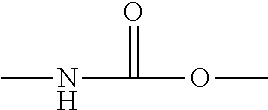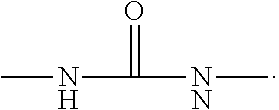Polyurethane urea solutions for textile coatings
a technology of polyurethane urea and textile coating, which is applied in the field of textile coating process, can solve the problems of low water stability of the corresponding polyurethane coating produced from organic solutions, poor processability, and poor mechanical properties, and achieve high percentage elongation at break, good mechanical properties, and good processability
- Summary
- Abstract
- Description
- Claims
- Application Information
AI Technical Summary
Benefits of technology
Problems solved by technology
Method used
Image
Examples
example 1
on of a Polyurethane Urea Solution in Ethanol (Inventive)
[0308]150 g of POLYTHF 2000 and 37.50 g of POLYTHF 1000 were dewatered under membrane pump vacuum at 100° C. for one hour in a standard stirrer apparatus and then initially charged at 80° C. under nitrogen. Then 75.06 g of isophorone diisocyanate were added at 80° C. within 5 min and stirring at 110° C. was continued (about 3 hours) until the NCO value had gone below the theoretical value. The prepolymer was cooled to 40° C. and it was dissolved in 630.4 g of ethanol (denatured with diethyl phthalate) and then the temperature was reduced to 15° C. Then a solution of 37.6 g of methylenebis(4-aminocyclohexane) (H12-MDA) and 270 g of ethanol (denatured with diethyl phthalate) was metered in within 30 min. Stirring was continued until no free isocyanate groups were detectable any longer by IR spectroscopy.
[0309]The resultant clear, storage-stable solution had the following properties:[0310]Solids content: 23%[0311]Viscosity (visco...
example 2
on of a Polyurethane Urea Solution in Ethanol (Inventive)
[0314]300 g of POLYTHF 1000 were dewatered under membrane pump vacuum at 100° C. for one hour in a standard stirrer apparatus and then initially charged at 80° C. under nitrogen. Then 133.44 g of isophorone diisocyanate were added at 80° C. within 5 min and stirring at 110° C. was continued (about 3 hours) until the NCO value had gone below the theoretical value. The prepolymer was cooled to 40° C. and it was dissolved in 517 g of ethanol (denatured with MEK) and then the temperature was reduced to 16° C. Then a solution of 58.8 g of methylenebis(4-aminocyclohexane) and 222 g of ethanol (denatured with MEK) was metered in within 30 min; then a further 410 g of ethanol were added. Stirring was continued until no free isocyanate groups were detectable any longer by IR spectroscopy.
[0315]The resultant clear, storage-stable solution had the following properties:[0316]Solids content: 30.2%[0317]Viscosity (viscometer, 23° C.): 85 00...
example 3
on of the Polyurethane Ureas Solutions from Examples 1 and 2 in Water
[0320]The polyurethane urea solution from Examples 1 and 2 coagulated spontaneously when it was introduced into water at room temperature.
[0321]In each case, a sample of the solutions from Examples 1 and 2 were diluted with ethanol to solids content 15% by weight and a glass rod was dipped therein at room temperature. The glass rod was subsequently dipped into a vessel containing demineralized water, and the surface of the polymer solution solidified immediately. An analogous experiment with water at 80° C. showed analogous results; in addition, the polymer sample became very turbid, which indicates good coagulation.
PUM
| Property | Measurement | Unit |
|---|---|---|
| molar mass | aaaaa | aaaaa |
| molar mass | aaaaa | aaaaa |
| flow rate | aaaaa | aaaaa |
Abstract
Description
Claims
Application Information
 Login to View More
Login to View More - R&D
- Intellectual Property
- Life Sciences
- Materials
- Tech Scout
- Unparalleled Data Quality
- Higher Quality Content
- 60% Fewer Hallucinations
Browse by: Latest US Patents, China's latest patents, Technical Efficacy Thesaurus, Application Domain, Technology Topic, Popular Technical Reports.
© 2025 PatSnap. All rights reserved.Legal|Privacy policy|Modern Slavery Act Transparency Statement|Sitemap|About US| Contact US: help@patsnap.com


